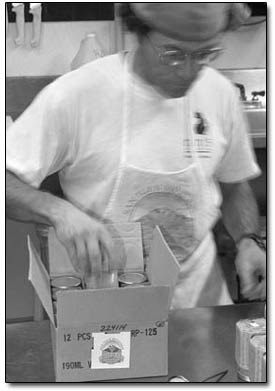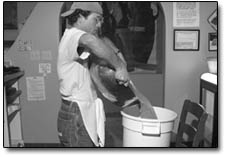|
San Juan Mountain Mustard Co. cranks
out grass roots condiments
written by Rachel
Turiel
 |
| San Juan Mustard Co. CEO and head
packer Paul Rappaport loads up a batch of his honey-dill
flavored Sweetwater Draw mustard. Rappaport bases
his mustards off a recipe from his New York grandmother./Photo
by Todd Newcomer |
It began almost 40 years ago in Brooklyn
with Grandma Louise’s mustard stash. Young Paul
Rappaport knew the pantry was filled with Grandma’s
special homemade blend of spicy, pungent mustard. One
night, Grandma, catching Paul reaching for the jar of
gritty, brown treasure, told her grandson “mustard
doesn’t go with our dinner tonight honey.”
To which a small but strong -willed Rappaport answered,
“It goes with my dinner.” And so a seed was
planted.
Although the San Juan Mountain Mustard Co. is just 1-year-old
this holiday season, Paul Rappaport (aka Colonel Mustard)
has been making mustard for more than two decades. Lonesome
for Grandma’s home cooking, he mixed his first batch
in college based on his mentor’s recipe. Due to
popular demand amongst his friends, Rappaport began making
a gallon at a time, spreading the joy throughout a small
community in Vermont.
Being outdoorsy, athletic and community minded, it’s
no surprise that Paul Rappaport would meet his future
wife, Stacie, in Vermont on a two-day, 150-mile bike ride
to raise money for multiple sclerosis. Redheaded Stacie,
co-proprietor and co-epicurean (as their business card
states), is busy. She talks fast, moves fast and is the
kind of person who knits, does yoga, gardens, skis, bikes,
and paints and landscapes her house and yard to perfection.
In 1992, the Rappaports had the opportunity to caretake
a farm in Vermont. With 40 gallons of maple syrup harvested
each year, and a garden full of horseradish root, Paul
and Stacie did the obvious: They made maple horseradish
mustard. Under the name “Green Mountain Mustard,”
with much respect and gratitude for Grandma Louise, they
launched their first mustard business.
Paul and Stacie laugh at their Green Mountain days: hand-written
labels Xeroxed and hand cut, sometimes with the list of
ingredients partially cut off in paper-cutter blunders.
The kitchen on their goat and cow farm was hardly certified
commercial, but they sold enough mustard to get to Alaska,
where they spent some time before their whirlwind travels
of the next four years to Oregon, Antarctica, New Zealand
and finally Durango in 1997.
It’s the mountains
Why Durango? Because of the mountains. Why mustard? Because
of the mountains. After years of teaching science and
working as a geologist in the oil and gas field, Paul
found a connection between what is undeniably good (mustard)
and what inspires him (mountains). While snowshoeing one
day in the Red Mountain area – the seeds of San
Juan Mountain Mustard already incubating in the minds
of the Rappaports – the couple was struck with the
direct connection between mustard and mountains: 1) If
they could work hard for a stretch, cranking out large
amounts of quality mustard, they’d have more time
to spend in the mountains; 2) San Juan Mountain Mustard
can help preserve their spectacular mountain home by donating
a percentage of its profits to local environmental groups.
That day on Red Mountain inspired the names of the five
original flavors offered by the mustard company. The bittersweet
maple-horseradish mustard reminded them of the bittersweet
boom and bust days of the early miners, and thus “Mad
Miners” maple-horseradish was born. A percentage
of the profits of Mad Miners Mustard goes to the Mountain
Studies Institute in Silverton, an organization that promotes
education and preservation of local ecology. The name
Cascade Creek, which was given to a creamy, Asian-style
spread, conjures up visions of snow cascading down mountainsides,
and thus proceeds of this mustard go to the Colorado Avalanche
Information Center, also in Silverton. “I call the
Avalanche Hotline every morning in winter,” Paul
says. “They’ve saved my butt many times.”
Tough town, sweet mustard
Durango’s a tough town, some say, but the Rappaports
have found nothing but support and encouragement for their
new venture. Paul, being the Colonel, makes all the mustard,
while Stacie, when she has a free moment from her
 |
| Rappaport mixes up an
industrial-sized batch of his honey-dill flavored
mustard in Nini’s kitchen./Photo by Todd Newcomer. |
practice as a physical therapist and massage therapist,
does everything else. For their first year, with a staff
of two, things have gone extremely well. The managers
of Nini’s Taqueria, whom Stacie plays ice hockey
with, let them rent out their commercial kitchen for production.
Several business owners 4
in town allow the Rappaports to ship ingredients and
supplies on their trucks for no charge. Lady Falconburgh’s
has replaced all their previous table mustard with SJM
mustard; Nature’s Oasis carries their Sweetwater
Draw (honey-dill) in bulk; and their five flavors can
be found at 26 different establishments in Durango.
What makes this mustard so special? It’s made locally,
in small batches, by humans. The only power tool used
is a blender. The sweeteners – molasses, maple syrup
and honey – are unique and add flavor not found
in the typical commercial, white-sugar mustards. It’s
made with all natural ingredients, no preservatives. You
can even buy it in bulk, eliminating the need for another
plastic, disposable package.
“Some of these things make it cost more.”
Paul Rappaport shrugs. “I could make a $1.50 yellow
mustard if I wanted to.”
“Mustard ain’t supposed to be yellow,”
Stacie says, frowning.
Indeed. If your mustard is bright yellow, it has been
colored with turmeric, a naturally yellow spice.
Fire on Red Mountain
Nini’s Taqueria, Sunday morning, 25F degrees outside:
Paul’s in the kitchen with mustard seeds. Neil Young
croons about shooting his baby on the CD player. Paul
winces as he stirs four gallons of molasses chipotle mustard,
also known as Fire on Red Mountain. The sting of vinegar
and spicy smoked jalapeF1os waft into his eyes. Brown
and yellow mustard seeds are swirled with dried, green
herbs and bright red peppers as each stroke of Paul’s
hand marries the ingredients further.
The Rappaports rent Nini’s kitchen by the hour.
Though never hurried, Paul calmly and methodically navigates
the task of making 8 gallons of mustard in four hours.
Each step is ticked off on a checklist. Stainless steel
tools, lined up on the table like surgical implements,
glint off the florescent lights. Molasses and vinegar
are measured out ahead of time, waiting for the precise
moment when they will be added to the mix.
Though this work is culinary chemistry, the process is
simple and low tech. The bottling equipment was rigged
from pieces at the hardware store – its main mechanism
is gravity. Between stirs on the large pot of mustard,
Paul replaces Neil Young with a Beatles classic. And when
a just-filled mustard jar overflows slightly, he is quick
and easy with a paper towel.
After some time, Stacie bursts in from the frigid November
morning and smiles at the neat rows of bottles filled
with ochre-colored mustard flecked with green and red
confetti. She rolls up her sleeves and sets in on the
sink of dishes. As Stacie washes and Paul places empty
glass jars under the ever-flowing mustard spout, they
share their vision for the future.
Ski more, work less
The Rappaports would like to get more ski resort contracts.
They’re already at Durango Mountain Resort, Vail,
Taos, Telluride and Wolf Creek. For Vail and Taos, they’ve
created a private label, featuring the name of the respective
local ski mountain, and will donate a percentage of profits
to an environmental cause specific to each area. “Wolfie
and Telluride don’t get private labels, they’re
in the San Juans,” Stacie explains.
They would also like to ski more. Or simply have more
time to get out into the mountains. “I never even
got into ‘tele-shape’ last winter,”
Stacie laments. In addition to making the mustard, there
are always bottles to label, orders to fill, phone calls
to return, deliveries to make. This is on top of Stacie’s
physical therapy work and the Spanish classes Paul teaches
at the high school.
“It’d be nice to hire someone to do the labeling,”
Paul muses. “It’s fair to say I have other
interests besides making mustard.”
The levelheaded Rappaports are not afraid to dream. They
see the potential in owning their own commercial kitchen
and being able to create jobs in Durango at their mustard
plant. Paul would like to see bicycle-powered blenders,
Stacie would like to work two days a week and spend the
other five in the San Juan Mountains.
Meanwhile, in an apartment in Brooklyn, Grandma Louise
continues to make her own spicy sauce, knowing all too
well the moral of this story: Pay attention to your grandmas,
they have wisdom we can all benefit from.
|

